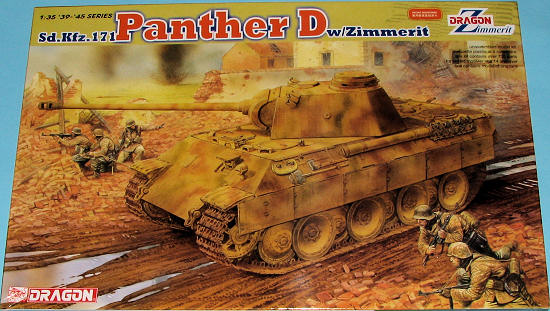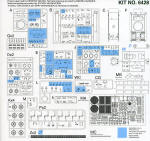
Dragon 1/35 Panther D with Zimmerit
| KIT: | Dragon 1/35 Panther D with Zimmerit |
| KIT #: | 6428 |
| PRICE: | $ |
| DECALS: | Two Options |
| REVIEWER: | Scott Van Aken |
| NOTES: | Multimedia kit with etched and cast metal parts. |

| HISTORY |
The Panther was a direct response to the Soviet T-34. First encountered on 23 June1941, the T-34 decisively outclassed the existing Panzer IV and Panzer III. At the insistence of General Heinz Guderian a team was dispatched to the Eastern Front to assess the T-34. Among the features of the Soviet tank considered most significant were the sloping armor, which gave much improved shot deflection and also increased the effective armor thickness against penetration, the wide track and large road wheels which improved mobility over soft ground, and the 76.2 mm gun, which had good armour penetration and fired an effective high-explosive round. Daimler-Benz (DB) and Maschinenfabrik Augsburg-Nürnberg AG (MAN) were tasked with designing a new thirty to thirty-five-ton tank, designated VK3002, by April 1942 (apparently in time to be shown to Hitler for his birthday).
The two proposals were delivered in April 1942. The Daimler-Benz (DB) design was a direct homage to the T-34, side-stepping the German propensity for over-engineering and, hence, complexity, to produce a clean, simple design resembling the T-34 in hull and turret form, diesel engine, drive system, leaf spring suspension, track layout, and other features. In the DB design, like the T-34 design, the internal crew layout provided for two men: the commander would also have to serve as the gunner. This provided the advantage of a smaller, inexpensive turret design, as well as manpower savings, and a smaller target for enemy gunners to hit during a battle.
The MAN design was more conventional German thinking: it was higher and wider with a substantial turret placed centrally on the hull, a petrol engine, torsion-bar suspension, and a characteristically German internal crew layout for three men: commander, gunner, and loader. The MAN design was accepted in May, 1942 in spite of Hitler's preference for the DB design. One of the principal reasons for this was that the MAN design used an existing turret designed by Rheinmetall-Borsig while the DB design would have required a brand new turret to be designed and produced, substantially delaying the commencement of production.
A mild steel prototype was produced by September 1942 and, after testing at Kummersdorf, was officially accepted. It was put into immediate production with the very highest priority. The start of production was delayed, however, mainly because there were too few specialized machine tools needed for the machining of the hull. Finished tanks were produced in December and suffered from reliability problems as a result of this haste. The demand for this tank was so high that the manufacturing was soon expanded out of MAN to include Daimler-Benz and in 1943 the firms of Maschinenfabrik Niedersachsen-Hannover (MNH) and Henschel & Sohn in Kassel.
The initial production target was 250 tanks per month at MAN. This was increased to 600 per month in January 1943. Despite determined efforts this figure was never reached due to disruption by Allied bombing, manufacturing bottlenecks, and other difficulties. Production in 1943 averaged 148 per month. In 1944, it averaged 315 a month (3,777 having been built that year), peaking with 380 in July and ending around the end of March 1945, with at least 6,000 built in total. Strength peaked on September 1, 1944 at 2,304 tanks, but that same month a record number of 692 tanks were reported lost (source: T.L. Jentz (1999) Die deutsche Panzertruppe Band 2).
The ausf D was the initial production version with less than 700 built. Many of these used zimmerit paste until it was discontinued in mid-late 1944.
| THE KIT |
 This is another of Dragon's 'super kits'. The kit box is full of all sorts of goodies that one would normally have to pick up in the aftermarket arena. Things like an aluminum gun barrel and etched metal parts. The hull and turret are already molded with the zimmerit paste so no need to go through the additional work of applying it. There is even z
This is another of Dragon's 'super kits'. The kit box is full of all sorts of goodies that one would normally have to pick up in the aftermarket arena. Things like an aluminum gun barrel and etched metal parts. The hull and turret are already molded with the zimmerit paste so no need to go through the additional work of applying it. There is even z immerit molded onto the aft storage boxes. Other bits are a metal gun barrel, etched engine compartment screens, metal side armor skirts, metal width indicator poles, and a number of parts in their Gen2 slide molding process that provides a higher quality of detail on parts.
immerit molded onto the aft storage boxes. Other bits are a metal gun barrel, etched engine compartment screens, metal side armor skirts, metal width indicator poles, and a number of parts in their Gen2 slide molding process that provides a higher quality of detail on parts.
In addition, you get Dragon's excellent single piece DS tracks. These flexible tracks have superb detail, can be painted without worry of the paint flaking and can be cemented using a variety of glues.
This kit lists over 700 parts so it is not a kit for the beginner, but for those who want the greatest amount of detail and do not mind putting in the effort to get it.
Dragon's instructions are in full color and superbly done via CAD drawings. Dragon uses both Model Master and Gunze paint references to be sure you'll have the proper shades for this one. Markings are provided for two tanks. One is the box art tank in a base of panzer yellow with brown and green splotches. The other has broad green swaths of paint and is numbered black 232. Both are from unidentified units in 1943. The small decal sheet provides the minimalist markings for these two tanks.
| CONCLUSIONS |
Dragon has become a name synonymous with quality and accurate model armor. Their dedication to detail does provide a kit that is not for the tyros, but those who want the best will get it with this one. Like all of Dragon's special releases, this one will not be around long so get it while you can.
| REFERENCES |
http://en.wikipedia.org My thanks go to www.dragonmodelsusa.com for the preview kit. Get this one at your local shop today or have them order one for you. April 2008 If you would like your product reviewed fairly and fairly quickly, please contact the editor or see other details in the Note to Contributors.